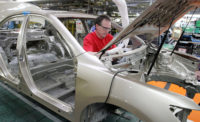Shoichiro Toyoda, who led Toyota Motor Co.’s expansion into North America and set the company on a path to becoming one of the world’s most powerful automakers, died Feb. 14 at 97.
The son of Kiichiro Toyoda, the company’s founder, Shoichiro Toyoda joined the business in 1952. In 10 years, he had risen to the position of managing director. He was promoted to senior managing director in 1967, executive vice president in 1972, and president of the company’s marketing organization in 1981. He became president of the company in 1982 and served as chairman from 1992 to 1999.
Fifty years ago, Toyota was seen as an existential threat to the Detroit Three automakers and U.S. manufacturing jobs. Today, it’s hard to overstate the company’s benefit to this country. Toyota operates 14 factories in North America, including 10 in the U.S., and the company employs more than 176,000 Americans.
During 35 years of manufacturing here, the company has invested more than $30.6 billion in U.S. production, made more than 29.9 million vehicles, and donated more than $1.14 billion to U.S. charities. In 2020 alone, the company assembled 1,003,753 vehicles and spent $26.4 billion on domestically produced parts and materials.
Shoichiro Toyoda, who led Toyota Motor Corp.’s expansion into North America and set the company on a path to becoming one of the world’s most powerful automakers, died Feb. 14. Photo courtesy Toyota Motor Corp.
In 1973, Toyota also established a design studio, Calty Design Research Inc., here. Calty has two facilities: one in Newport Beach, CA, for concept designs, and another in Ann Arbor, MI, for production designs. Calty provides both interior and exterior styling proposals for future Toyota vehicles and advanced design, production color and wheel design concepts for Toyota’s product development operations.
“I am deeply saddened by the passing of Shoichiro Toyoda, who was not only an important legacy to Toyota but an integral part of Calty’s establishment 50 years ago,” wrote Ian Cartabiano, vice president of advanced design at Calty, in a post on Linked-In. “Toyoda was the visionary with the revolutionary idea to open the first major automotive design studio on the West Coast, and we are forever grateful for his support and wisdom.”
But the company’s U.S. presence just the tip of the iceberg. The company’s impact on U.S. manufacturing extends well beyond the automotive industry. The Toyota Production System—and the company’s willingness to evangelize about it—changed U.S. manufacturing culture forever.
“The world lost a great leader with the passing of Shoichiro Toyoda, honorary chairman and former president of Toyota Motor Corp,” wrote Larry Culp, chairman and CEO of General Electric, in a post on Linked-In. “His lasting impact in driving lean and quality manufacturing will be felt for generations to come—not only at Toyota but across the thousands of leaders and companies he has inspired through his visionary leadership and his commitment to excellence and continuous improvement.”
Toyoda guided development of the luxury-brand Lexus onto global markets in 1989, which quickly challenged similar models of Mercedes, BMWs and other high-end models. Toyota beat everyone with the first hybrid car, the Prius, which was released in Japan in 1997 and abroad in 2000. Ford Motor Co. would not introduce a hybrid model until seven years later.
In 2007, Toyoda was inducted into the U.S. Automotive Hall of Fame. He was lauded for cementing “Toyota’s reputation as one of the most recognized and celebrated auto manufacturers in the world.”
Domo arigato, Toyoda-san.



